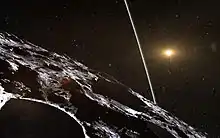163 Erigone
163 Erigone is an asteroid from the asteroid belt and the namesake of the Erigone family of asteroids that share similar orbital elements and properties. It was discovered by French astronomer Henri Joseph Perrotin on April 26, 1876, and named after one of the two Erigones in Greek mythology.
| Discovery | |
|---|---|
| Discovered by | J. Perrotin |
| Discovery site | Toulouse |
| Discovery date | 26 April 1876 |
| Designations | |
| (163) Erigone | |
| Pronunciation | /ɪˈrɪɡəniː/[1] |
Named after | Erigone |
| Main belt (Erigone) | |
| Adjectives | Erigonian /ɛrɪˈɡoʊniən/[2] Erigonean /ɛrɪɡəˈniːən/ |
| Orbital characteristics[3] | |
| Epoch 31 July 2016 (JD 2457600.5) | |
| Uncertainty parameter 0 | |
| Observation arc | 123.56 yr (45131 d) |
| Aphelion | 2.8188 AU (421.69 Gm) |
| Perihelion | 1.9161 AU (286.64 Gm) |
| 2.3675 AU (354.17 Gm) | |
| Eccentricity | 0.19064 |
| 3.64 yr (1330.5 d) | |
| 280.031° | |
| 0° 16m 14.052s / day | |
| Inclination | 4.8148° |
| 160.166° | |
| 298.260° | |
| Earth MOID | 0.93686 AU (140.152 Gm) |
| Jupiter MOID | 2.3628 AU (353.47 Gm) |
| TJupiter | 3.518 |
| Physical characteristics | |
| Dimensions | 72.63±5.7 km[3] 72.70 ± 1.95 km[4] |
| Mass | (2.01 ± 0.68) × 1018 kg[4] |
Mean density | 9.99 ± 3.45 g/cm3[4] |
| 16.136 h (0.6723 d) | |
| 0.0546±0.010[3] 0.0428 ± 0.0092 [5] | |
| C[5] (Tholen) | |
| 9.47,[3] 9.48[5] | |
Erigone is a relatively large and dark asteroid with an estimated size of 73 km.[4] Based upon its spectrum, it is classified as a C-type asteroid,[5] which indicates that it probably has a carbonaceous composition.
2014 occultation of Regulus
_Erigone_as_it_occults_Regulus_on_March_20%252C_2014.jpg.webp)
In the early morning hours of March 20, 2014, Erigone occulted the first-magnitude star Regulus[6] as first predicted by A. Vitagliano in 2004.[7] This would have been a rare case of an occultation of a very bright star visible from a highly populated area, since the shadow path moved across New York state and Ontario, including all five boroughs of New York City.[7] Observers in the shadow path would have seen the star wink out for as long as 14 seconds.[6][8]
However, heavy clouds and rain blocked the view for most if not all people on the shadow path.[9] The website of the International Occultation Timing Association does not list any successful observations at all.[10]
Two single chord Asteroid Occultation events have been observed, in 2013 and 2015.[11]
References
- Noah Webster (1884) A Practical Dictionary of the English Language
- Publius Ovidius Naso, John Gower (1640) Ovids Festivalls
- "163 Erigone". JPL Small-Body Database. NASA/Jet Propulsion Laboratory. Retrieved 12 May 2016.
- Carry, B. (December 2012), "Density of asteroids", Planetary and Space Science, 73 (1): 98–118, arXiv:1203.4336, Bibcode:2012P&SS...73...98C, doi:10.1016/j.pss.2012.03.009. See Table 1.
- Pravec, P.; et al. (May 2012), "Absolute Magnitudes of Asteroids and a Revision of Asteroid Albedo Estimates from WISE Thermal Observations", Asteroids, Comets, Meteors 2012, Proceedings of the conference held May 16–20, 2012 in Niigata, Japan, 1667 (1667), p. 6089, Bibcode:2012LPICo1667.6089P. See Table 4.
- Dunham, David (2006). "The International Occultation Timing Association 24th Annual Meeting at Mt. Cuba Observatory, Greenville, Delaware". International Occultation Timing Association. Archived from the original on 18 July 2011. Retrieved 13 February 2011.
- Vitagliano, Aldo (2010). "The Solex Page". Università degli Studi di Napoli Federico II. Archived from the original on 20 December 2008. Retrieved 13 February 2011.
- Preston, Steve (14 March 2014). "(163) Erigone / HIP 49669". Asteroid Occultation. Archived from the original on 24 December 2013. Retrieved 14 March 2014.
- Asteroid eclipse rained out Space.com 2014 March 20
- Regulus 2014 International Occultation Timing Association
- "PDS Asteroid/Dust Subnode". sbn.psi.edu. Archived from the original on 25 April 2018. Retrieved 25 April 2018.
External links
- 163 Erigone at AstDyS-2, Asteroids—Dynamic Site
- 163 Erigone at the JPL Small-Body Database



